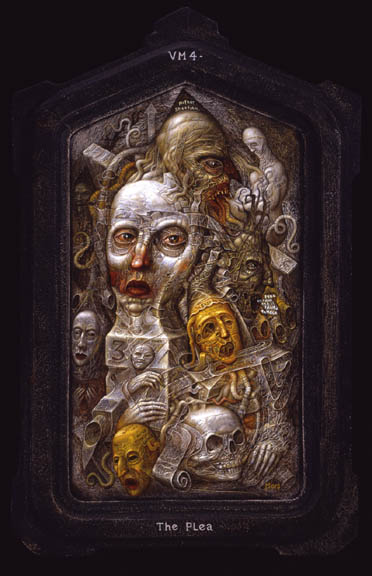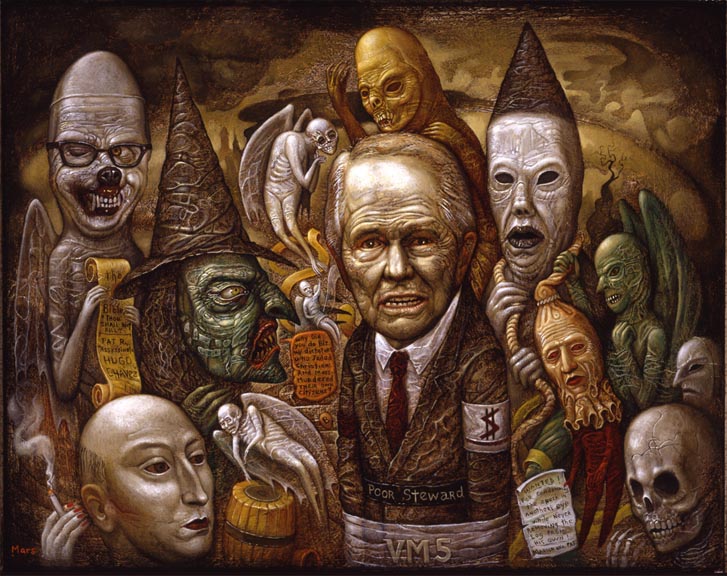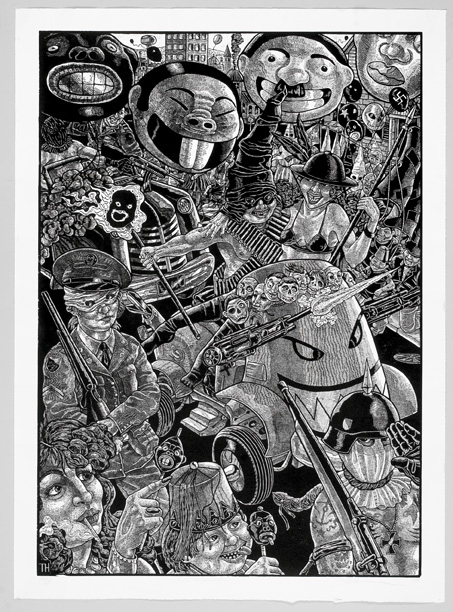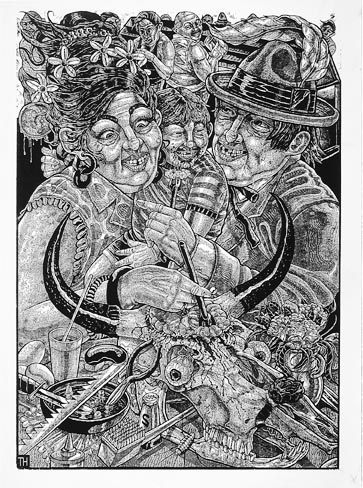Beautiful Monsters: Chris Mars’ “Subderma” and Tom Huck’s “Bloody Bucket”
Mark Wojahn reviews the work of Chris Mars and Tom Huck, related through the relentlessness of their dystopic visions. The work is at the Minneapolis Institute of Arts and at Rogue Buddha Gallery.






Chris Mars shows with James Cleary at the Minneapolis Institute of Art,MAEP Gallery,
Sept. 23- Nov. 20, 2400 Third Ave, in Minneapolis; and
Tom Huck shows at the ROGUE BUDDHA gallery Sept. 30 -Nov. 12,
357 Thirteenth Ave. NE, Minneapolis.
Throughout time, artists have given us insights into the world that average individuals refuse or fail to explore. Think of Vincent Van Gogh, using his brush to shatter an impressionistic reality with expressive starry nights and self-portraits.
The Surrealists followed suit a generation later, delving into our understanding of how we interpret the subconscious. These movements in art propelled visual interpretation of society to new heights and they strove to emancipate humanity with fresh perspectives. In shows at the Minneapolis Institute of Art and Rogue Buddha Gallery, the artists Chris Mars and Tom Huck similarly peel back and cut into society’s skin to reveal what is really going on.
I like to think of Minneapolis artist Chris Mars as our aesthetic Dr. Frankenstein. He has transformed half of the MAEP gallery into a magic mirror to look at society’s dark side. With Renaissance detail he lovingly builds his “uniquely formed” creatures with brush and oil. A horrific vision of society results but it is with such care the good doctor brings these “monsters” to life that viewer is drawn to look at them.
The new Subderma series of oil painting on panels continues earlier work of Mars illustrating his family’s history of mental illness. This time, Mars unleashes his demons (in three of the twenty-two paintings) in a bold and relevant direction: he paints on current political events. These paintings, VM (“Victims of Myth”)
3-5, reframe politicians and activists such as Cindy Sheehan, George Bush, and Pat Robertson within a context of society’s greater mental derangement.
Gone is the ungrounded, personal and dreamy ambiguity of the other works in this show. The viewers now have a literal reading of the artist’s intent. The viewer is pushed to recognize that our leaders have turned to the dark side to achieve their goals and motivate their followers. While this work is powerful, relevant, and surprising, time will tell if Mars’ political insights will survive. It seems that only the best of political art survives in an ADHD world of headlines and spin.
Chris Mars has a lot going for him here and adding overt politics gives his work more firepower. His paintings stop you cold because they are of a world slowed down. They are oil paint thinned with Ritalin. His brushstroke lures us in and allows us to spend time with the mentally ill he depicts. Our eyes meet theirs and we have a chance to empathize, forgive, or relate. It is Mars’ gift to society and he has replaced the “fastburn” of his rock n’ roll past with a detailed contemplation of psychosis. Subderma’s prescription for us is this dose of pain(t), injected into our IVs, to stimulate a cure for a world slipping toward the dark ages.
In a separate vein, at the Rogue Buddha gallery, Tom Huck supports the thesis that the world is going down the toilet with his massive 3×5 foot black-and-white woodcut prints on paper. Huck’s scenes are inspired by “hillbilly” events from his home in Missouri and from nationalistic events cut into our skin with the animated sensibility of a tattoo artist. The prints richly depict events of Americana inked with disgusting cruelty, humor and violence.
Huck’s art bludgeons us with views of crack whores and the triple amputees that fuck them, a veterans’ day parade that brings a Col.Kurtz back from Apocalypse Now with Hirohito and Hitler in tow or a country family devouring a beef brain buffet (skull included).
Gallery Owner Nicholas Harper says, “Huck makes art by the inch” and this statement rings true as each fraction of a Tom Huck print provides notes on our cultural disintegration. In many of the backgrounds, Huck provides important references for this disintegration. For instance, in two of the prints, a John Lennonesque figure dances in the background, seemingly unaware of the horrors around him. In “Last Days of Lactation”, darkly lit individuals are drunk on mother’s milk as the scene before them spins out of control. I believe that just may be what Huck’s art is about: a world spinning out of control, obsessed with fear, violence, and lust. Meanwhile, the enlightened dance their time away in song or shadow.
Tom Huck’s prints and Chris Mar’s paintings easily brain stain the viewer with their Abu Ghraib-like images. I sense that inside each of the artists is an uncanny but fundamental fear of our moral and mental decline. At their worst, these artworks repel us with their disgusting portrayals of our society. They beat us over the head with a hell-and-brimstone take on our loss of morality and the grotesque. This may in turn encourage many viewers to reject their perspective and to support the very stereotypes that they may intend to address. But at their best, they both may envision behaviors and a world view that fully exists but that many refuse to look at.
These artistic explorers are bravely walking the plank to glorify and/or vilify our world’s ills. Maybe that is also why I believe they succeed. In consuming these images the viewer is asked, Do you accept this world? If so, turn and fight; if not, continue on into the abyss.